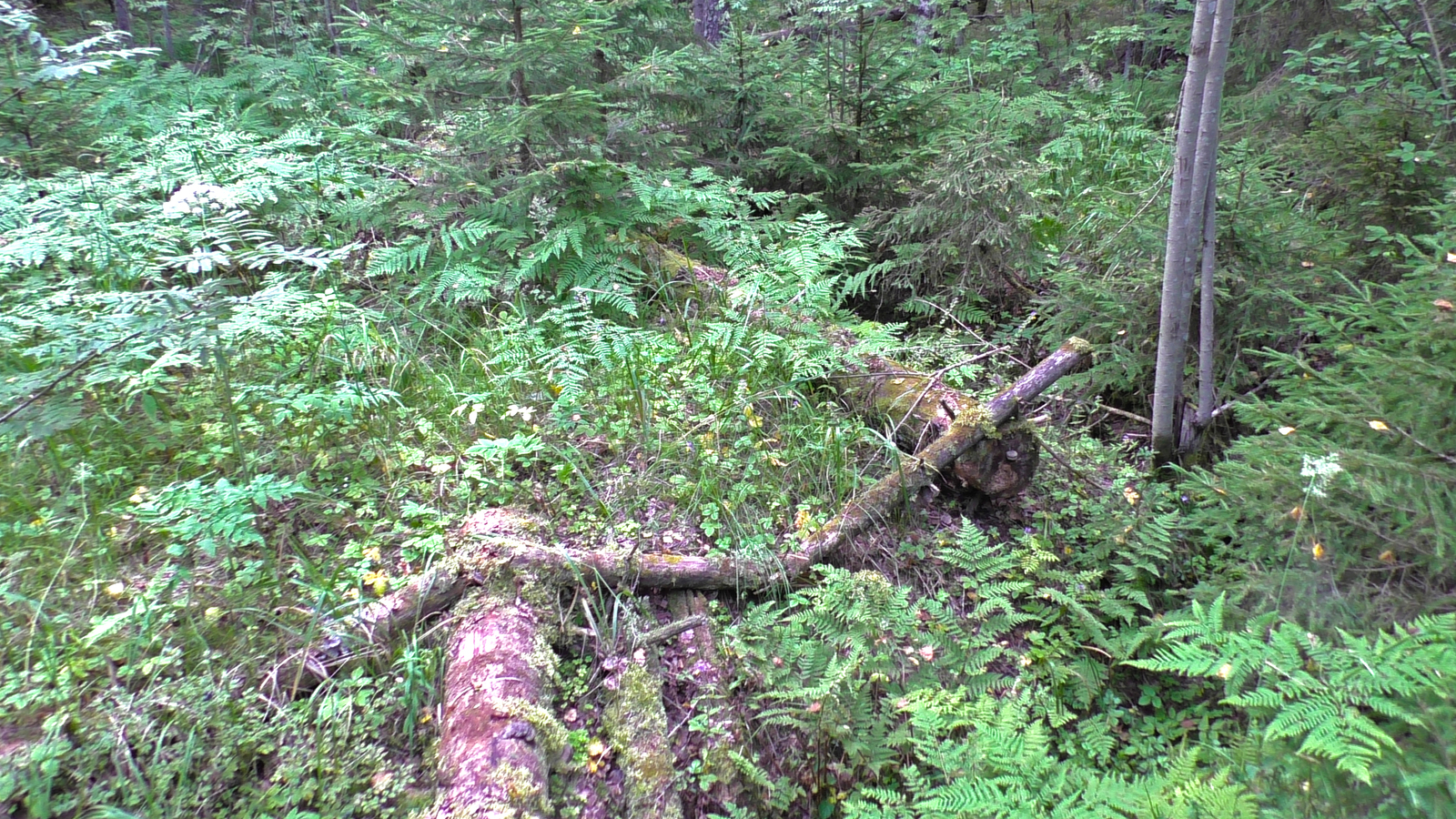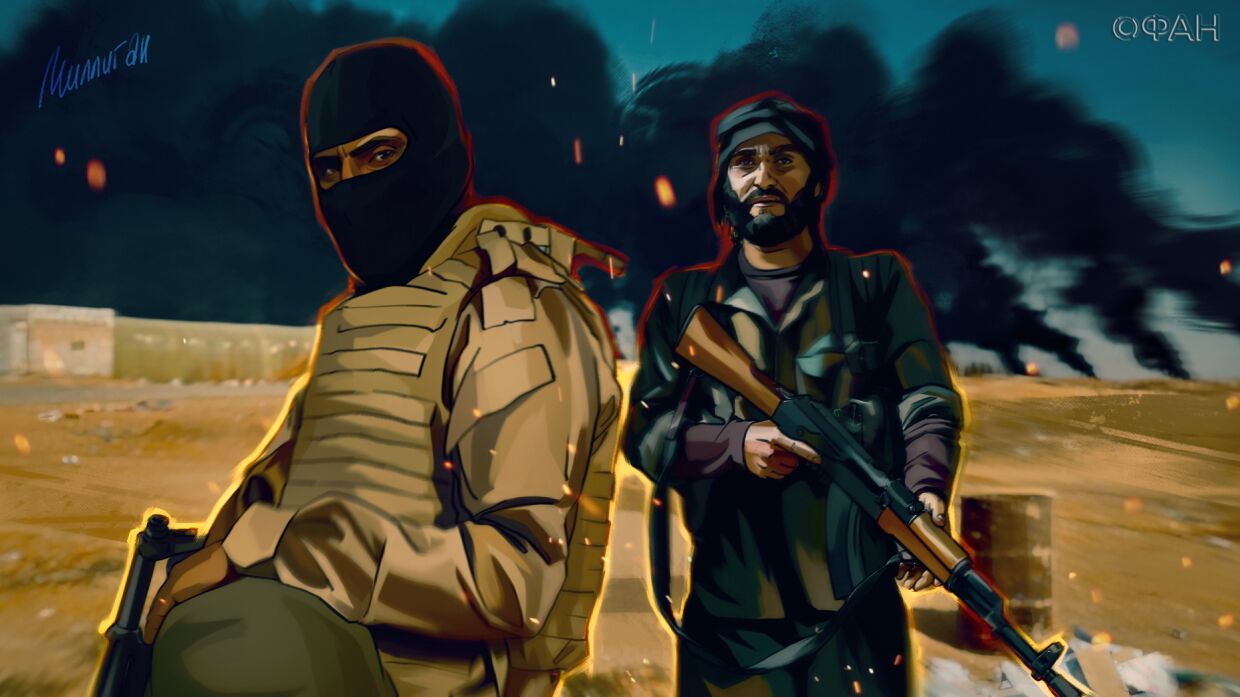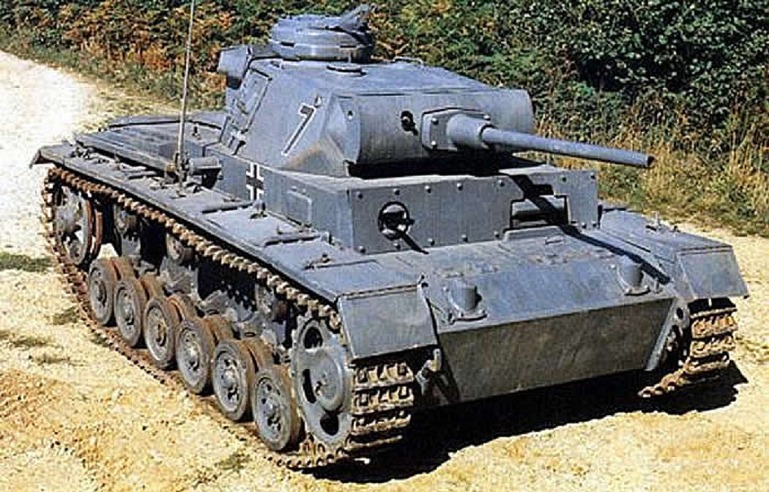
Panzerkampfwagen III - German medium tank of World War II, serially produced with 1938 by 1943 year. Abbreviation of the tank were the PzKpfw III, Panzer III, Pz III. In the departmental heading of military equipment by Nazi Germany, this tank had the designation Sd.Kfz. 141 (Special vehicle 141 - special-purpose machines 141). In Soviet historical documents and popular literature PzKpfw III was known as "Type 3", T-III or T-3.
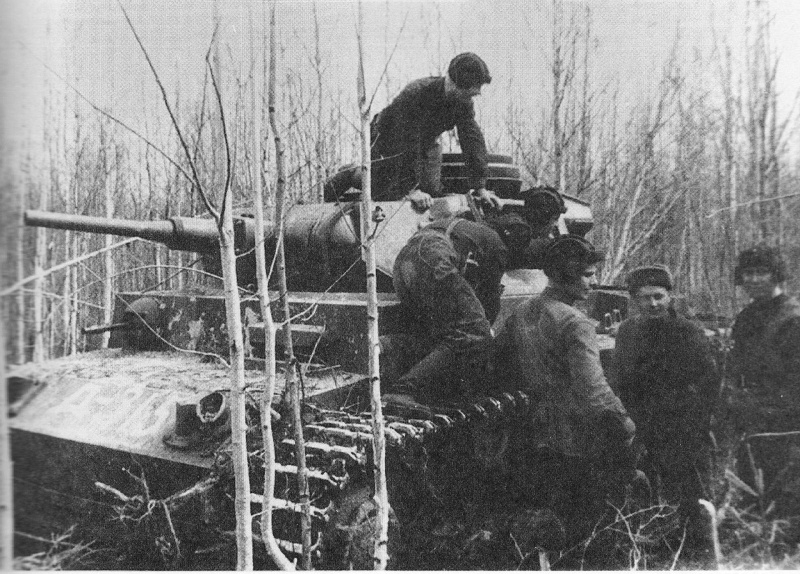
Trophy tank Pz.Kpfw. III from the Soviet 107th tank battalion. Volkhov front, April 1942 of the year.
These combat vehicles used by the Wehrmacht from the first day of World War II. The last record of the combat use of PzKpfw III in regular Wehrmacht divisions date from the middle 1944 of the year, single tanks fought until the surrender of Germany. Since the mid 1941 originally 1943 , the PzKpfw III was the backbone of the armored troops of the Wehrmacht (pancervaffe) and, despite the relative weakness compared with his contemporary anti-Hitler coalition tanks, made a significant contribution to the success of the Wehrmacht of the period. This type of tanks supplied the armies of Germany, Allied Axis. Captured PzKpfw III with good results used by the Red Army and allies. Based on the PzKpfw III in Germany and the Soviet Union created a self-propelled artillery (HEALTHY) for different purposes.
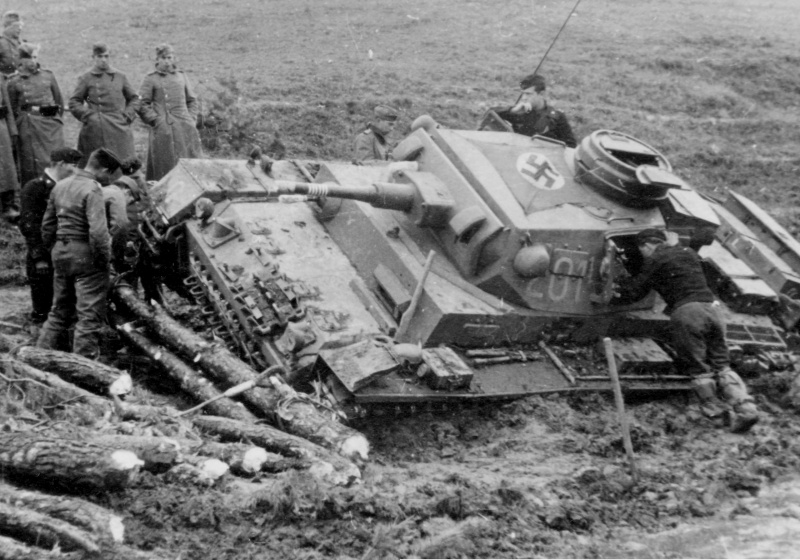
German soldiers around stuck in mud Pz.Kpfw.III Ausf.J medium tank skid № 201 from the 17th Panzer Division (17.Pz.Div.) Wehrmacht. Eastern front. On the roof of the tower is fixed opoznovaniya flag for its aircraft.
History of the creation and production
train driver car
although Germany, defeated in World War I, under the terms of the Treaty of Versailles it was not allowed to have armored forces, work on the creation of armored vehicles were in it since 1925 of the year. the first tank, running eventually became light tank PzKpfw I, then known under the code name "Small tractor", (it. Kleintraktor), which was being developed with 1930 of the year. At the same time, disadvantages PzKpfw I, who had a crew of two, Machine-gun armament and bulletproof book, It was evident even at the stage of its design, so the need for more heavy tanks soon Office Reichswehr arms was formulated. According to "Krupp" company documents for 1933 year, Arms Control planned creation of two tanks - a few more, than PzKpfw I and armed 20mm cannon, Future PzKpfw II, the development of which was assigned the company "Daimler-Benz" armed and 37mm cannon and who had a weight of about 10 ton tank, the contract for which is planned to get the "Krupp". The final decision on the early development of the two machines was made after held 11 January 1934 year's meeting of the Office of arms guidance on the definition of the priority programs under the conditions of lack of funding. Formal permission to start work on the tank (it. Battle tanks) It was issued by the Office Inspectorate of Armored Forces 27 January of the same year.
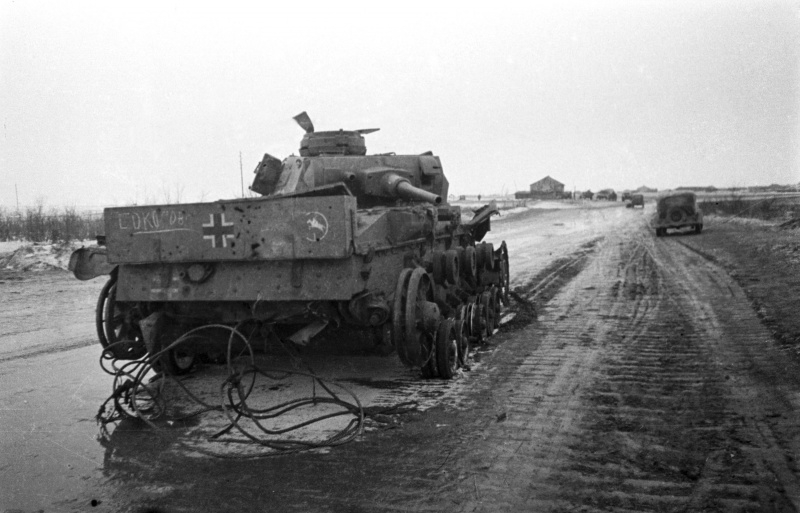
German tank Pz.Kpfw. III from the 24th Armored Division of the Wehrmacht (24. Panzer-Division), padded at Stalingrad
In February 1934 by the Office of arms competition to develop a new tank it was organized, received the code name "tank platoon commander" (it. train driver car) or Z.W. After exploring the possibilities of different companies, to participate four firms were invited to tender: «Daimler-Benz», "Krupp", M.A.N. and "Rheinmetall". Technical requirements to the tank included:
– about weight 10 tonnes;
– armament of 37mm cannon in a rotating turret;
– the maximum speed of not less than 40 kmh;
– use of engine HL 100 power 300 l. from. produced by "Maybach", SSG transmission 75 фирмы gear factory Friedrichshafen, Wilson-Cletrac pivot mechanism type and caterpillars Kgs.65 / 326/100.
After examining the preliminary draft, presented by "Daimler-Benz", M.A.N. and "Rheinmetall", The control of arms in the summer 1934 year orders for the production of prototypes were issued:
– "Daimler-Benz" - two prototype chassis;
– M.A.N. - a prototype chassis;
– "Krupp" - two prototype tower;
– "Rheinmetall" - a prototype of the tower.
According to the results of tests of prototypes, the chassis was chosen "Daimler-Benz", the first copy of which was collected in August 1935 of the year. In addition to the first gear, designated as Z.W.1 and Z.W.2, "Daimler-Benz" was awarded a contract to build two more improved prototypes - Z.W.3 and Z.W.4. Two towers "Krupp" prototype was completed in August more 1934 of the year, but finally they were chosen only after comparative tests together with the towers, "Rheinmetall" on prototype chassis.
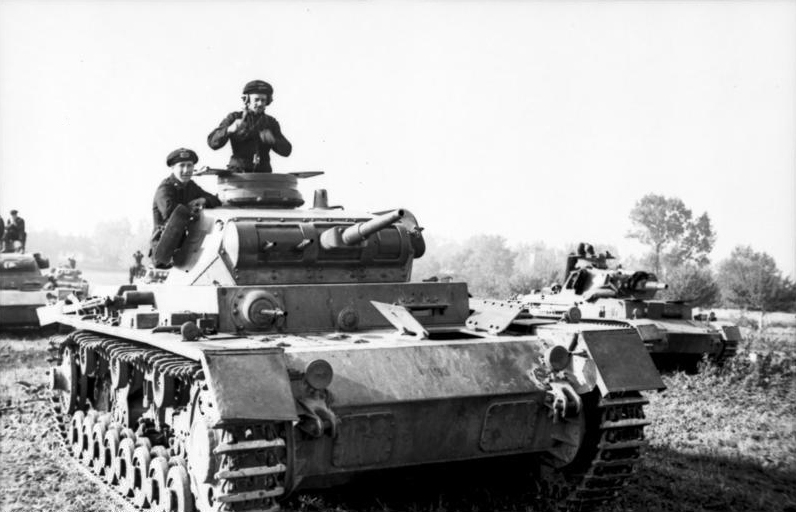
PzKpfw III Ausf. D, Poland, 1 September 1939 of the year.
Panzer III Ausf. A, B, C и D
An order for the production of "zero series" of 25 tanks, intended for military trials, It was issued by the Office of arms in December 1935 of the year, with the release of the first tank was scheduled for October 1936 year in order, to transfer all 25 machines by the troops 1 April 1937 of the year. By the time the tank designation changed several times, while the order of 3 April 1936 years has not been established in the final version - Panzerkampfwagen III.
The contract for the production of the first pre-series batch (1.Series / Z.W.) of 10 machines has been issued the company "Daimler-Benz", tower for the tanks had to be put "Krupp". In addition to these, in the production of a number of other companies were involved, produces separate units and tank components. So, body armor and book towers were manufactured by the company "Deutsche Edelshtalverke", a number of other companies supplying optical devices and components of the power plant and the chassis[9]. Ten machines of this series, received later designation Ausführung A (ausf. A - «model A»), It is the development of a prototype design Z.W.1. A characteristic feature of this modification was Chassis, with five large-diameter supporting rollers with individual vertical suspension springs and two supporting rollers on each side. Weight Ausf. A was 15 tonnes, top speed was below the requirements of the customer and accounted for only 35 kmh. "Daimler-Benz" had planned to complete the assembly of the two chassis by November 1936 of the year, but really the start of production Ausf. A zatyanulos to 1937 of the year. The exact release date machines of this modification is unknown, but it is known for their rough period - between 1 May 1937 of the year, when, according to reports, It has not yet been made a single tank and 1 October of the same year, When the number is already in service 12 PzKpfw III.
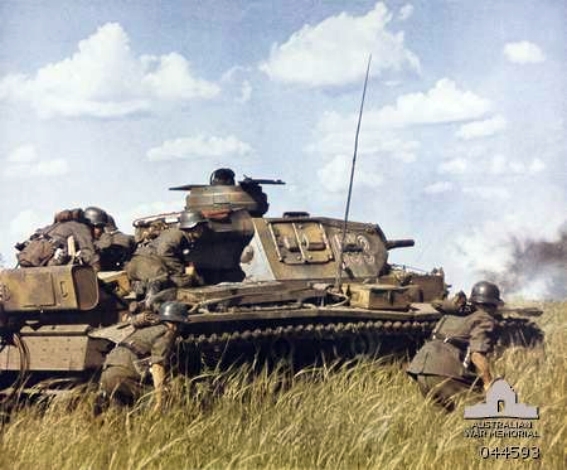
German tank desant on the T-III, 1941 year.
second order, issued by "Daimler-Benz" and "Krupp", It provides for the production of the second pre-series batch (2.Series / Z.W.) of 15 machines, Z.W.3 constitutes a development of the prototype and received the designation Ausf. B[6]. from Ausf. A distinguished primarily by their running gear, which had on each side of 8 Small diameter rollers, semi-detached pairs in the bogie, hanging on two groups of leaf springs and is equipped with hydraulic shock absorbers. Besides, in the design of the tank was introduced a number of less significant changes. Five chassis Ausf. B were diverted for the production of zero series ACS Sturmgeschütz III, so as tanks, according to the German documents were completed only 10 of them, Although many sources however say 15 issued tanks this modification. After testing all 5 machines Zero series Sturmgeschütz III up to 1941 the year used for educational purposes. Production of tanks of this modification commenced after the completion of work on the machines from the party Ausf. A, and the last tanks Ausf. B were delivered to the troops by the end of November - beginning of December 1937 of the year.
An order for a third party pre-production PzKpfw III (3.Series / Z.W.) of 40 The tank was also issued "Daimler-Benz" and "Krupp", also issue was brought to the series as the previous, and new sub individual nodes and tank components. 3.Series / Z.W. It included the two parties - 3a.Serie / Z.W. of 15 machinery and 3b.Serie / Z.W. of 25 machines, received the designation, respectively, ausf. C and Ausf. D. Structurally Ausf. C different from the tanks Ausf. B is primarily a modified suspension, 8 which rollers on each side were now arranged in three trucks - two extremes of the rink and the average of the four rollers, still suspended on leaf springs, and extreme truck also on shock absorbers. Besides, aggregates were improved powerplant, first of all steering gear and final drives. production Ausf. C was carried out from mid 1937 January 1938 of the year.
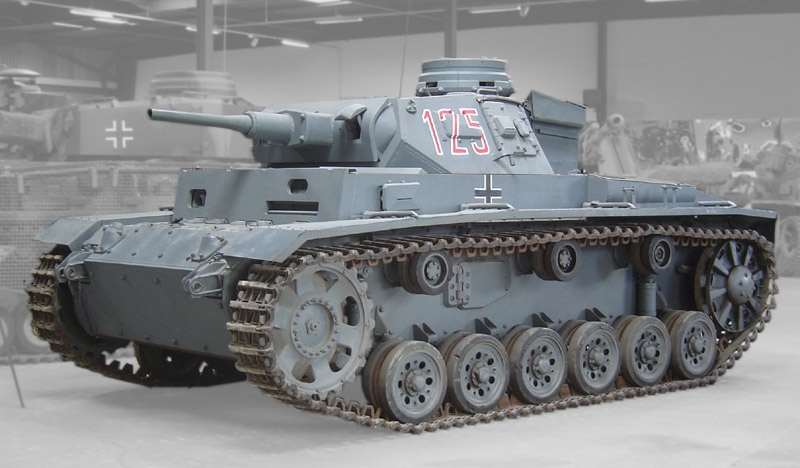
German tank PzKpfw III Ausf. H
The last modification of pre PzKpfw III Ausf became. D. Tanks of this modification differ modified stern of the hull and turret of a new design commander, and changes in power plant suspension cells. Many features Ausf. D, eg, aft structure, moved later to the production machines. With regard to the reservation of tanks of this modification, historians opinions differ. It is the traditional version of the 30-mm vertical booking Ausf. D, as well as on the tanks of the first production versions, According to various sources, this book had all, or else all except the first 5 machines, tanks Ausf. D. However, this version is disputed by historian T. Yencem, pointing to the, These data, like many other, come from British intelligence reports, written during World War II and shortly after it, and are merely wrong assumptions. Sam Jenc, based on German documents of that period,, claims, that book all Ausf tanks. D remained unchanged in comparison with the previous modifications, and 30-mm armor had a new commander's cupola. production Ausf. D began in January 1938 of the year, right after the completion of Ausf. C. According to German documents, the report of 1 July 1938 year the number of armed 56 Panzer Ausf. A — Ausf. D, but, versions of historians, poslednie Ausf. D were released back in June or July 1938 of the year. The initial order Ausf. D was 25 machines, however, due to the fact, what 5 shassi Ausf. B have been allocated previously for the construction of self-propelled guns, remain unclaimed already made for them the upper part of the hull and turret and arms control board Order "Daimler-Benz" manufacturing 5 Additional chassis 3b.Serie / Z.W.(№№ 60221-60225). However, by the time the priority was to have the production of the next series of PzKpfw III, so the assembly of these five cars, referred to in some documents as 3c.Serie / Z.W., It occurred only in October 1940 of the year. Exactly these 5 tanks, received by the 40th Tank Battalion of Special Assignment in Norway, We took part in the beginning of the operation “Barbarossa” in northern Finland. Total, in this way, it was made 30 Ausf modifications tanks. D, although some sources name and numbers in 29 or even 50 machines.
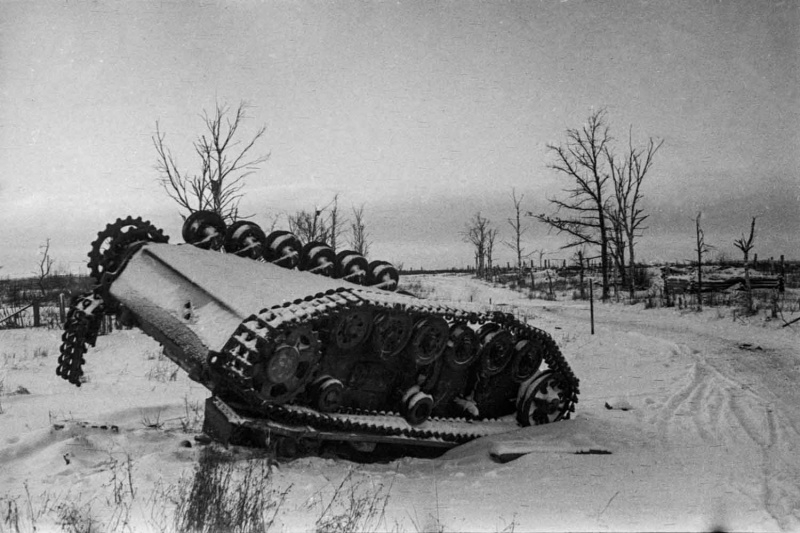
German tank Pz.Kpfw. III, padded and overturned on the Eastern Front.
Production
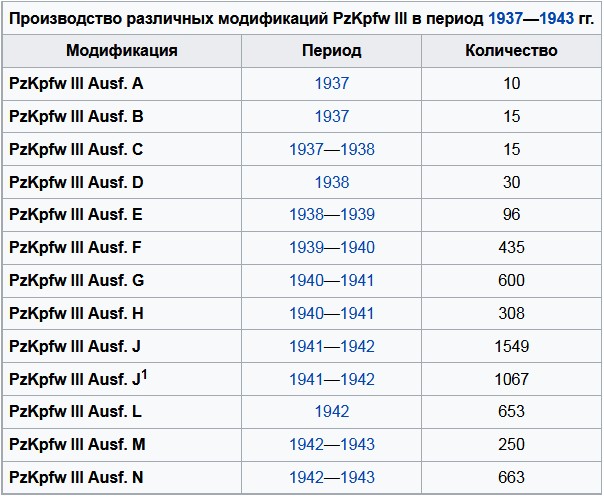
modifications
At the end of summer 1940 of the year 168 tanks Panzerkampfwagen III version F, G and H were converted for movement under water, and were to be used when landing on the British coast. immersion depth was 15 m; Fresh air is supplied hose length 18 m and diameter 20 cm. spring 1941 years of experience has been continued with a 3.5 m pipe - "snorkel". Since landing in England did not take place, a number of such tanks from the 18th Panzer Division 22 June 1941 year broke on the bottom of the Western Bug.
Most of 600 Tank versions F and G, built before the end of 41 year had a new arms 50 mm cannon and can respectively at distances less 500 meters withstand armor T-34 (bead). And partly HF (bottom of the body of the forehead).
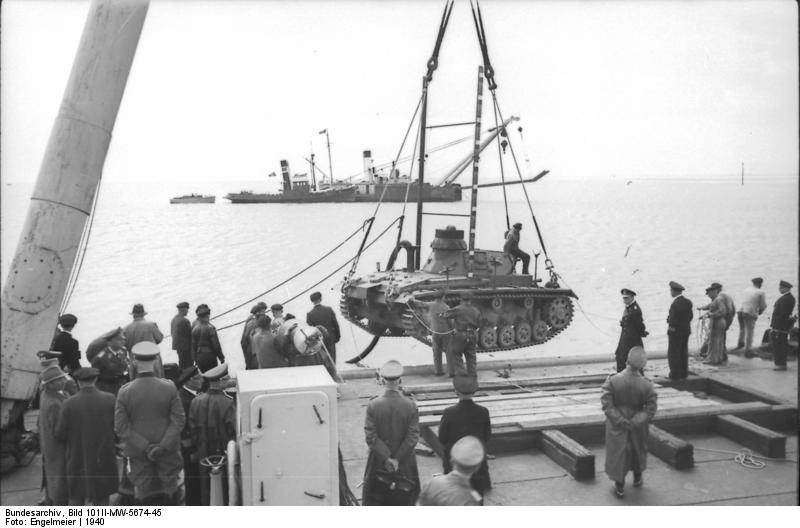
Diving Panzer III
Design
PzKpfw III had the composition at a location in the aft engine compartment, transmission compartment - front, and driver's compartment and the crew compartment - in the middle of the tank. The crew PzKpfw III consisted of five people: the driver and radio operator-gunner, located in the control room and Commander, gunner and loader, are placed in the three-tower.
weaponry

Zabronevoe effect of armor-piercing shells are not always effective because the projectile was severely injured, piercing generally have an unpredictable effect zabronevoy. This further reduces the efficiency of the fire. Given the caliber of these factors have had sufficient value (Manual offensive level gauge (light) grenades). On the other hand in the closed space and the dense arrangement of any detrimental effect. By the end of the war with increasing caliber projectiles on armor effect reached destructive effect (IS-2 after a series of hits without breaking lose body strength and began to fall apart, under the influence of its large-caliber shells become more fragile German armor destroyed even with the first hit in large volumes (shift tower overhead on 20 See more)).
observation and communication tools
All tanks PzKpfw III were equipped with radio FuG 5, placed on the gearbox, left arrow-radio operator. Wireless range - 6,4 km and phone 9,4 km telegraph. Internal communication between crew members carried out using TPU and lighting device.
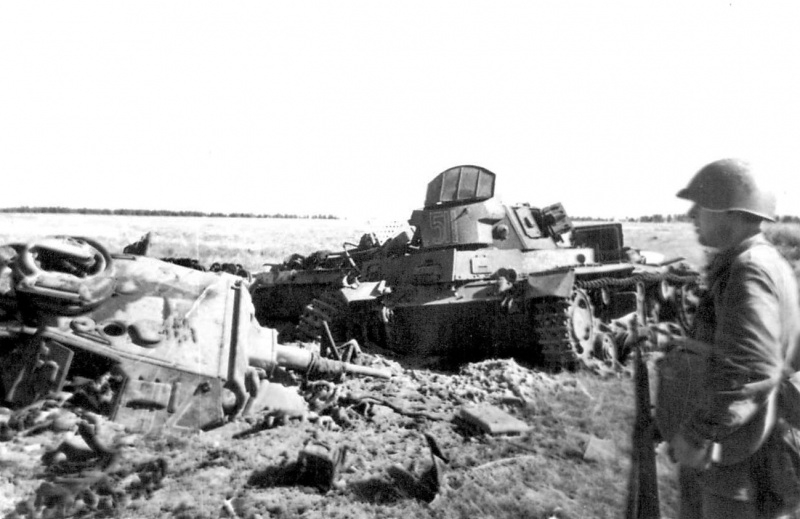
Red Army soldiers inspect the German tanks Pz. Kfpw. III, lined near Mogilev. Machines were hit units 388 th Infantry Regiment.
Engine and transmission
All modifications were equipped with twelve-petrol carburettor engines Maybach. Modifications Ausf.A-Ausf.D - engine capacity HL108TR 10.8 l, power 250 HP. Modifications Ausf.E-Ausf.N - engine capacity HL120TR 11.9 l, power 300-320 HP. Structurally, the second motor is the development of the first; motors differ diameter cylinder and compression ratio.
transmissions: modifications Ausf.A-Ausf.D - shestistupenchataya (+5;-1); modification Ausf.E-Ausf.G - chetyrnadtsatistupenchataya (+10;-4); modifications Ausf.H-Ausf.N - semistupenchataya (+6;-1). Chetyrnadtsatistupenchataya manual Ausf.E-Ausf.G modification is the so-called rare type bezvalnoy preselektivnoy manual model Maybach Variorex.
Mechanism of rotation - one-speed planetarnыy. It consisted of two identical differential gears, one for his side, a dual function - the function of directly turning the mechanism and function of one of the steps of the main transmission reduction. Each differential gear unit has a rotation brake. Managing turning mechanism - two levers, each of which is connected both with its rotation brake, and a brake stopping its board. Group drive stopping brakes - pedal.
The main gear had three reduction stages. The first stage consisted of Geared bevel gear to transmit torque from the gearbox to a common drive shaft rotation mechanism. The second - from a pair of differential gears turning mechanism. Third - a pair of cylindrical gears board. Total gear ratio for the different versions - 7-9 depending on the type of engine and gearbox.

Running different versions of the tank
Chassis
Chassis tank vary widely. Common features of all were – traditional for the German tank arrangement leading front wheels, and sloths from behind, availability of support rollers. Road wheels were obrezinena. modifications (it. “Execution” or “Fin.”) They differ in the number of rollers, their size, shock-absorbing structure. It should be noted, that in the course of evolution, three fundamentally different variants of depreciation were used.
ausf. A: the only modification to the spring suspension (by the spring on each rink), two supporting rollers (all the rest – three), five supporting rollers enlarged diameter.
ausf. B, C, D: eight road wheels of reduced size, suspension spring. У exemplary. B two semi-elliptic leaf springs relied ends on rollers, semi-detached pairs, ausf. C, D already had three springs, and at last spring arranged at an angle.
ausf. E, F, G, H, J, K, L, M, N: Suspension torsionnaya, six road wheels of medium size. Modifications differed, basically, the size of rollers and a rubber band, structure and pattern of the drive wheel and the idler.
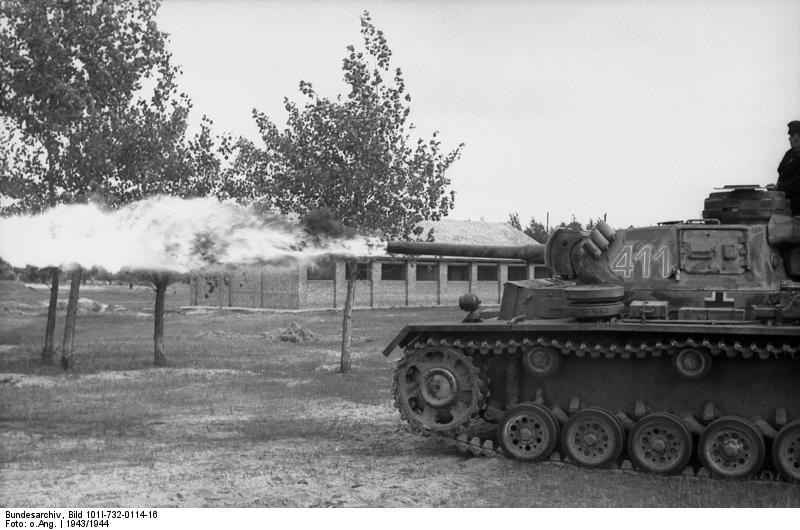
Flammpanzer III (Sd.Kfz. 141/3), Eastern front 1943/1944 years.
Machines based on Panzerkampfwagen III
On the basis of the linear PzKpfw III built special tanks and armored vehicles:
in Germany:
– Panzerbefehlswagen III - command tank;
– Flammpanzer III - ohnemёtnыy tank;
– Tauchpanzer III - tank underwater stroke;
– Artillerie-Panzerbeobachtungswagen III - armored artillery observation (machine advanced artillery observers);
– Assault Gun III - САУ;
– Sturmhaubitze 42 - ACS;
– Storm infantry gun 33 Ausf.B;
in USSR (on the basis of captured tanks):
– SU-76I - SAU;
– SU-85i - SAU;
– SG-122 - SAU.
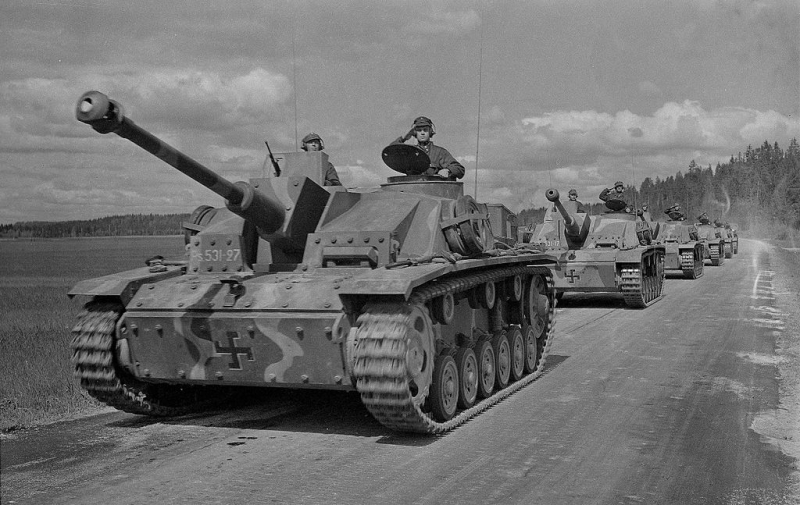
StuG III Ausf. G Finnish Armored Division
combat application
The invasion of the USSR
By the time of the invasion of the Soviet Union PzKpfw III was the main weapon of the tank units of the Wehrmacht. On 22 June 1941 year in the divisions, designed in the Soviet Union, there were about 1000 Machines of this type, that is from 25 to 34 % of the total number of tanks, designed in the Soviet Union.
As part of the tank battalion PzKpfw III were in light tank companies (three platoons of five tanks of this type, plus two of the tank - in the management of the platoon. The tank battalion of two companies.)[25]. In this way, typical Panzer Division invasion period in the USSR, with one tank regiment had ended dvuhbatalonnogo 71 unit combat supplies PzKpfw III plus 6 - special commander to control. In fact, the division into light and medium tank companies in 1941 year was formal. From the end 1940 , the armored divisions were reorganized (instead of a tank brigade dvuhpolkovogo composition are left on one shelf two or three battalion staff) and the main machine light tank company was the Pz III (17 Pz III и 5 Pz II in each), and medium - Pz IV (12 Pz IV и 7 Pz II). In this way, Each tank battalion had 34 tank Pz III. Yet 3 tank Pz III were platoon commanders of the regiment. So typical Panzer Division (not equipped with tanks Czech) I was in the structure of 71 to 105 Pz III tanks depending on the number of tanks in a tank regiment battalion.
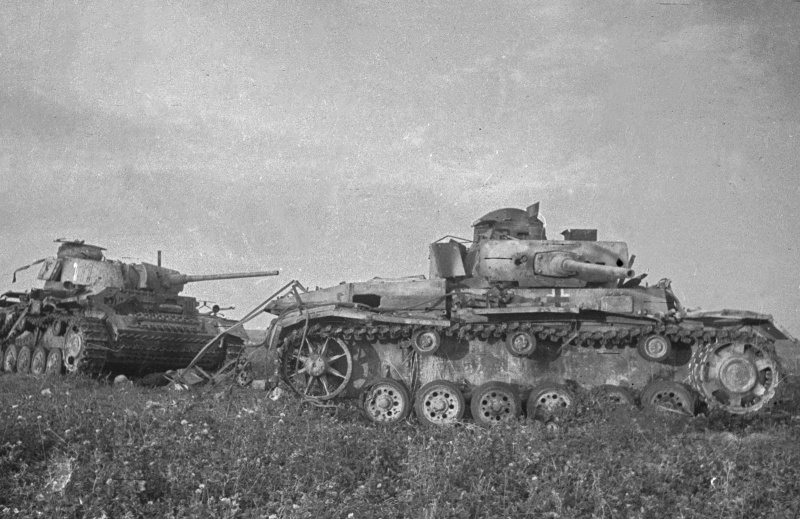
Padded at the Kursk Bulge tanks Pz.Kpfw. III Ausf M pantsergrenaderskoy division SS "Totenkopf" (SS-Panzergrenadier-Division «Totenkopf»)
PzKpfw III in the Red Army
During the Polish campaign 1939 year trophy of the Red Army has become damaged German tank PzKpfw III (In Soviet documents received name “20-ton medium tank Daimler-Benz”), which was kept secret from the Germans taken to the Soviet Union and submitted to the study NIIBT.
In the ensuing military-technical cooperation with the Third Reich had reached an agreement to buy another tank PzKpfw III Ausf. F. Both German cars were subjected to scrutiny, including sea trials and firing of 45-mm anti-tank gun mod. 1937 Armored year range in Moscow Kubinka. The test results have produced a great impression on the Soviet military leadership - on the level of their mobility, of security and usability crew PzKpfw III Ausf. F was recognized in the Soviet Union as the best foreign tank in its class, in many ways superior to T-26 mod. 1931 g. It was given the task to finalize the draft of the new light tank, taking into account the information, obtained in the study of German tank:
... It should not delay a minute to continue work on the tank "126" in order to bring all of its characteristics to the level of the German machine (or exceed it)…
From a letter to the chief GBTU I. n. Fedorenko K. E. Voroshilov 13 / IX / 1940
This allowed not only to identify their weaknesses, advantages and disadvantages compared with domestic tanks, but also to obtain sufficient experience in their operation. It will be useful later, Red soldiers in combat when capturing steel easily serviceable or repairable PzKpfw III. There integer division rank to a separate tank battalion, fully equipped with this type of tanks. Voenizdat was issued "Guidance Service for the use of captured tanks T-III». The failed due to technical reasons tanks PzKpfw III beyond repair (but, in comparison with the Soviet tanks, German tanks were trudnoremontiruemymi). Comfortable crew working conditions, quality optics and radio (although incompatible with the frequency range for communication mezhtankovoy taken in the Red Army) led to, that captured PzKpfw III became the favorite staff car. In 1941-1942, adopted PzKpfw III was quite sufficient to deal with any type of armor, standing on the Wehrmacht. However, there was a shortage of trophy caliber ammunition 37 and 50 mm. And in 1943 year, these instruments were no longer sufficient caliber armor against new and modernized German tanks. Therefore, at the end of 1942 - early 1943 the newly captured and the remnant of the previously exploited PzKpfw III steel converted into self-propelled guns SU-76i, Armed 76mm cannon-1 with ammunition 98 shells. Total was made at least 100-130 SU-76I. By the end 1943 year due to combat losses, non-combat injuries and lack of spare parts ("Three" have become rare even in the Wehrmacht) SU-76i and very few PzKpfw III disappeared from the ranks of the Red Army.
4 April 1944 Separate the station of Odessa region trophy Soviet troops 3rd Ukrainian Front began to train with 25 tanks T-III.
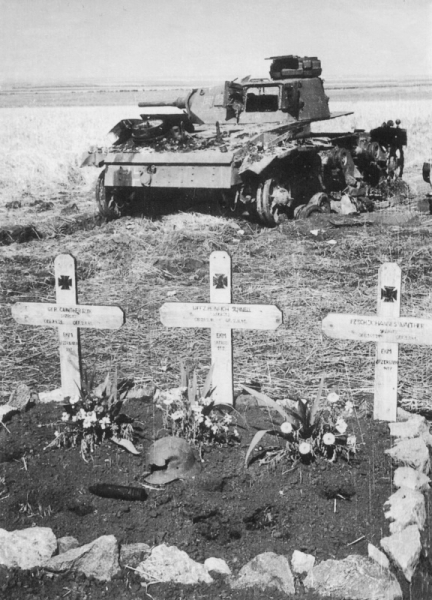
The grave of the German tank on the background of their tanks destroyed Pz.Kpfw. III. The photo was taken in the band steps 9th German Armored Division 1st Tank Group, belonging to the group "South" Army. On the cross - the date of death 2 August 1941 g.
Evaluation of the machine
Tank PzKpfw III was on the whole a typical representative of the German school of tank, but with some essential features, inherent in other design concepts. Therefore, in its design and layout decisions he, one side, succeeded advantages and disadvantages of classic layout "German type", and on the other - I had some negative features of its. In particular, Individual torsion suspension with road wheels of small diameter machines were uncharacteristic German, although it is very well-proven in the production and operation. Older "Panther" and "tigers" were less reliable in maintenance and repair and constructively more complicated for traditional German tanks "chess" suspension.
In general PzKpfw III is a reliable, manageable machine with a high level of comfort for the crew work, its modernization potential was quite enough for the 1939-1942 years. On the other hand, in spite of the reliability and manufacturability, overloaded chassis and turret box volume, insufficient to accommodate the more powerful cannon, We did not allow her to remain in production longer 1943 of the year, when all provisions for the conversion of "mild-to-medium" tanks into a full medium have been exhausted.
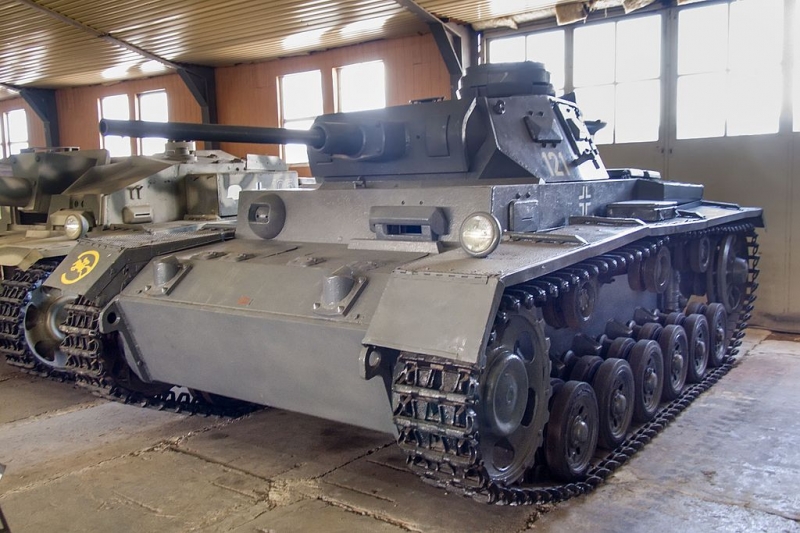
Pz.Kpfw.III Ausf.J1 in armored museum in Kubinka
Performance characteristics of the T-3
Crew, pers.: 5
developer: Daimler Benz
years of production: 1939—1943
years of operation: 1939—1945
The number of issued, PC.: 5691
The layout: engine compartment behind, front gear, combat and control the middle
Weight of tank T-3
– 19,8 tonnes
Dimensions of the T-3
– body Length, mm: 5380
– housing width, mm: 2910
– Height, mm: 2500
– Clearance, mm: 385
Armor tank T-3
– Type broni: chrome-nickel steel rolled, surface hardened
– housing forehead (top), mm / city.: 30 / 9°
– housing forehead (middle), mm / city.: 25 / 87°
– housing forehead (through), mm / city.: 30 / 21—52° — 25 / 75°
– body board, mm / city.: 30 / 0°
– housing feed (top), mm / city.: 20 / 30°
– housing feed (middle), mm / city.: 20 / 10°
– housing feed (through), mm / city.: 20 / 65°
– Bottom, mm: 16
– corps roof, mm: 16 / 75—90°
– tower forehead, mm / city.: 30 / 15°
– gun mantlet, mm / city.: 30
– board towers, mm / city.: 30 / 25°
– tower feed, mm / city.: 30 / 0—25°
– tower roof, mm: 10 / 83—90°
Arming of the T-3
– Caliber guns and stamp: 37-мм KwK 36, 50-мм KwK 38 / KwK 39, 75-мм KwK 37
– gun type: nareznaya
– barrel length, calibres: 46,5 / 42 / 60 / 24
– gun ammunition: 125
– sights: telescopic T.Z.F.5a
– Shotgun: 3 Mm × 7,92-MG-34
Engine tank T-3
– engine's type: V-shaped 12-cylinder liquid-cooled Carburetor
– Engine power, l. from.: 285
The rate of tank T-3
– Road speed, kmh: 67
– Speed over rough terrain, kmh: 15
– Cruising on the highway, km: 165
– Cruising cross country, km: 95
– power density, l. p. / m: 14,6
– suspension type: individual torsion, with hydraulic shock absorbers
– Unit ground pressure, kg / cm²: 0,9
– Gradeability, city.: 30°
– to overcome the wall, m: 0,6
– trench, m: 2,3
– fording, m: 0,8
Photo T-3
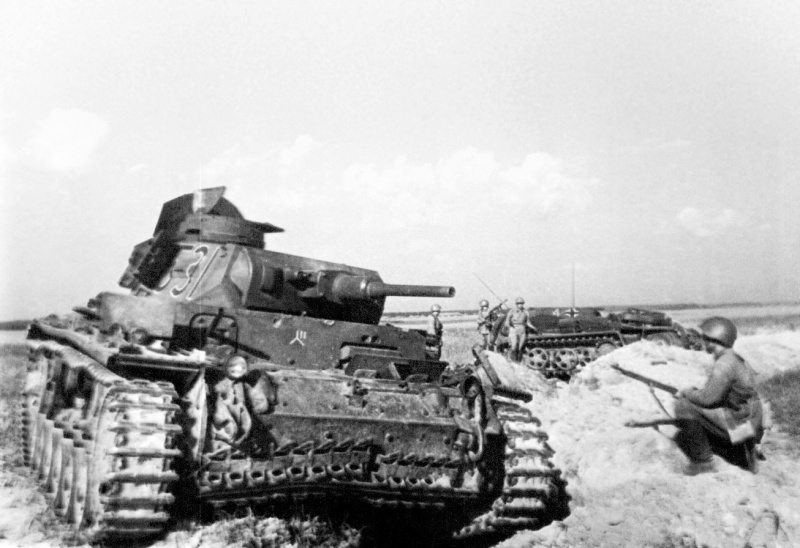
German tank Pz.Kpfw. III Ausf. E 3rd Armored Division (3.Pz.Div.), captured near the village of Buinichi, during the defense of Mogilev. In this area, led fierce battles 172nd Infantry Division Major General Romanov MT. presumably, the tank was captured by fighters of 388 th Infantry Regiment. In the background German armored vehicle Sd.Kfz.253 le Beob.Pz.Wg
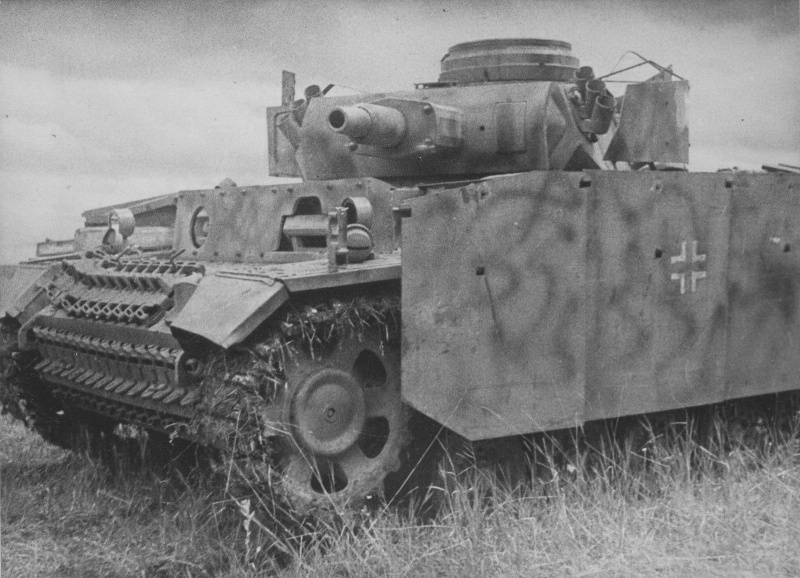
German medium tank Pz.Kpfw.III Ausf. N with mounted screen, thrown in Ukraine.
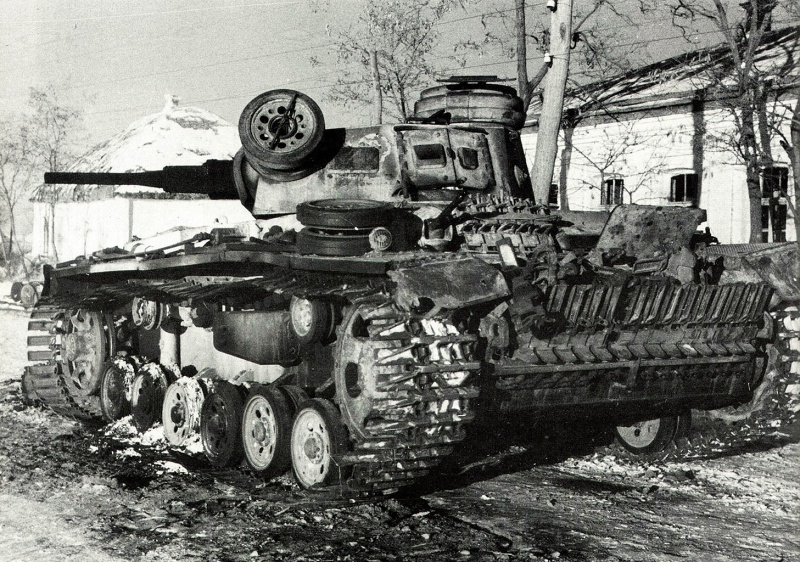
The wounded German tank Pz.Kpfw. III Ausf. J early series of the 9th Armored Division Wehrmacht, equipped with a so-called "oriental" caterpillar (Ostketten). Winter 1942-1943 g.
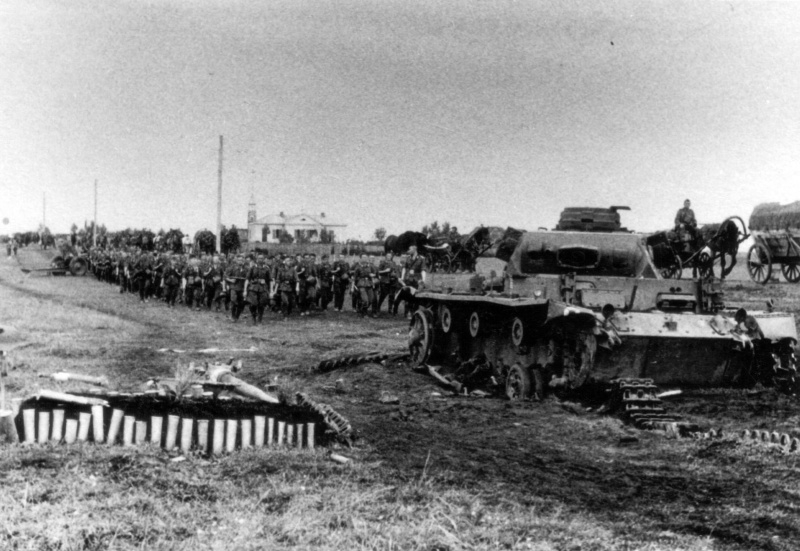
Padded near Bobruisk German tank Pz.Kpfw. III and the tomb of the crew with him.







